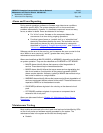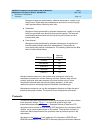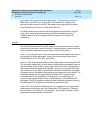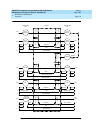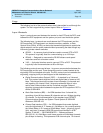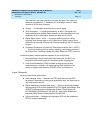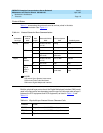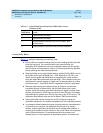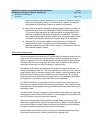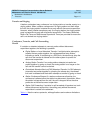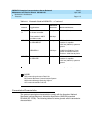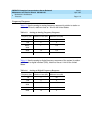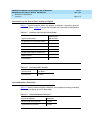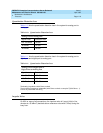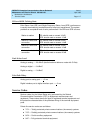
DEFINITY Enterprise Communications Server Release 5
Maintenance and Test for R5vs/si
555-230-123
Issue 1
April 1997
Maintenance Architecture
Page 1-10Protocols
1
member is always inserted automatically for calls to off-premises sites via
analog or voice-grade trunking. For internal calls, however, the systems
are capable of automatically inserting a modem-pool member.
■ Data cannot be carried over analog facilities unless inside the system it is
represented as a Pulse Code Modulation (PCM)-encoded analog signal.
To do this for data originating at a digital terminal, the signal enters the
system at a digital port and exits the system at a digital port. The signal
then reenters the system through a modem-pool connection (data-module
to modem to analog-port) and exits the system again at an analog port.
■ Although DS1 is commonly called a trunk speed, here it names the
protocol used at layer 1 for digital trunks. Some trunks use different
signaling methods but use DS1 protocol at layer 1 (for example, PRI and
24th-channel signaling trunks).
Disconnect Supervision
Disconnect supervision means the CO has the ability to release a trunk when the
party at the CO disconnects, and the system is able to recognize the release
signal. In general, a CO in the United States provides disconnect supervision for
incoming calls but not for outgoing calls. Many other countries do not provide
disconnect supervision on either incoming or outgoing calls.
The system must provide the assurance that at least one party on the call can
control the dropping of the call. This avoids locking up circuits on a call where no
party is able to send a disconnect signal to the system. Internal operations must
check to be sure one party can provide disconnect supervision. An incoming
trunk that does not provide disconnect supervision is not allowed to terminate to
an outgoing trunk that does not provide disconnect supervision.
In a DCS environment, an incoming trunk without disconnect supervision can
terminate to an outgoing DCS trunk connecting two nodes. The incoming trunk is
restricted from being transferred to a party without disconnect supervision on the
terminating node.
This is because, through messaging, the terminating node knows the originating
node cannot provide disconnect supervision. This messaging is not possible with
non-DCS tie trunks, and the direct call is denied.
Some two-wire loop start trunks outside the United States provide busy tone
disconnect in place of line signals. For these trunks, an adjunct can be attached
to the trunk to listen for busy or other disconnect tone. When a tone is detected,
the adjunct sends line signals for disconnect to the system.
Administration is provided for each trunk group to indicate whether it provides
disconnect supervision for incoming calls and for outgoing calls.



